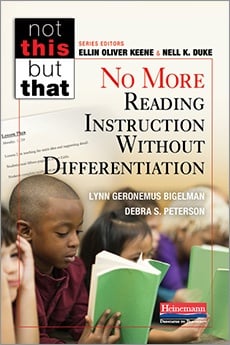
The research says it: when teachers differentiate reading instruction, students learn more. In their new book, No More Reading Instruction Without Differentiation, authors Lynn Bigelman and Debra Peterson offer a framework to adapt instruction based on individual students' needs and interests. In this post adapted from the first section of the book, Lynn breaks apart the idea of one-size-fits-all instruction and understands, truly, that one size only fits some students, some of the time.
One Size Fits Some
by Lynn Geronemus Bigelman
As I wander through the department store searching for the perfect sweater, I am confronted by a multitude of styles, colors, textures, and sizes. In bold letters is a tag reading, “One size fits all.” I know from firsthand experience that the tag should read, “One size fits some.” People are amazingly diverse, and very little fits everyone.
This department store dilemma is not unlike the one present in every classroom in every town and city across our country. We cannot grab instruction from a shelf and assume it will fulfill the needs of all our students. Our decisions about what will work for each student must be informed by observation, assessment, and planning. Even though each year we strengthen our professional knowledge and plan our instruction, it is impossible to determine each child’s needs until that child is sitting in front of us.
When One Size Doesn’t Fit Everyone
As an educator, parent, and grandparent, I have witnessed what can happen when a child’s needs are not met by one-size-fits-all instruction. In my second-grade classroom, high-spirited Kyle seemed to be making great leaps in reading. It looked to me as if he were comprehending, but he was reading texts only with pictorial support. When he began reading chapter books, I discovered he was missing some foundational skills. I realized this not because of any assessment I gave but because Kyle boldly asked me, “What is a /k/nife [pronouncing the k]?” He was struggling to decode words. My class instruction was focused on interpretation—specifically, themes in a text—but how could Kyle tell me what the ideas were if he couldn’t read the words? This was an alarming awakening for me as his teacher.
Herein is revealed a significant obstacle in one-size-fits-all instruction. When we encounter a specific student’s need, as I did with Kyle, we can adjust our instruction to meet that need, but we don’t address the larger issue of other students’ needs. It’s like lengthening the sleeves of that one-size-fits-all sweater—it solves the problem for some, but not all, students.
For example, when Angelous, an English language learner (ELL) student in my class, needed help understanding the word table in a text he was reading, I pointed to the table we were sitting at. We were both pleased with the clarity achieved. But later, during a whole-group lesson on multiplication tables, Angelous looked confused. He needed to understand that the word table had different meanings in different contexts. For ELLs, mistaken interpretations often stem from knowledge: The Spanish word embarazada means pregnant, whereas the English word embarrass means something quite different. Many words with similar Latin roots in English and Spanish have very different meanings. Without targeted, intentional observation, assessment, and planning, it is too easy to move forward with whole-group instruction and leave some students stuck in their confusion.
One-size-fits-all instruction doesn’t work for all children because, obviously, children differ—in their knowledge and skills, in their interests, and in their cultural background. In elementary school, my son, regardless of the teacher or the text, was consistent in his disdain for reading. Also consistent was the fact that he was never given any choice in what he read. Several factors may have made a difference. For one, perhaps if he had been given more choice in selecting his reading material rather than being asked to read the same text all his classmates were reading, he may have discovered his love of reading much earlier. It was not until he was much older that he became an enthusiastic reader. Luckily, my grandson, a proud first grader, is being given some choice in his reading. His teacher has capitalized on his interest in informational texts about animals. He is now an excited and a highly engaged reader who can’t wait to learn from books. This juxtaposition of generations reminds me that differentiated instruction, or the lack of it, has a lasting impact on students’ lives.
♦ ♦ ♦ ♦
Lynn Bigelman has been a classroom teacher, reading specialist, and, for the past fourteen years, an elementary school principal. She has served as the president of the Michigan Reading Association and Oakland County Reading Council.
Debra Peterson is a consultant for the Minnesota Center for Reading Research at the University of Minnesota. She was the recipient of the International Literacy Association's Albert J. Harris Award for Reading Research.



